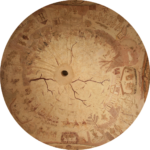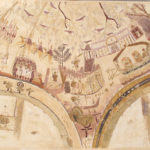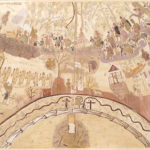| Artefact ID | 716 |
| TM ID | TM 397771 |
| Findspot (DEChriM ID) | 15 (al-Baǧawāt) | Class | Funerary element, Textual |
| Material | Plaster |
| Writing medium | Dipinto |
| Text content | Subliterary |
| Language | Greek |
| Description | SEG LIII 1979 (1-14): Labels accompanying paintings in the dome of the "Chapel of the Exodos". This chapel is unique in the necropolis, the whole interior is painted with scenes from the Old Testament, the largest one being a detailed representation of the Exodus which fills the whole circle. Painted labels, written in an informal uncial, allow the identification of the figures (Cipriano 2003): 1) Φαραώ; Ἐρυθρά; Ἰσραηλεῖται; Μωυσε̃ς; Ἰοθόρ (252); 2) Ἱε[ρο]υσαλήμ; [Ἱε]ρε-[μ]ίας (257); 3) Νῶε; κιβωτός (258); 4) Ζωή (Eva); Ἀ[δά]μ (260); 5) Δανιήλ ἐν λάκκῳ (262); 6) κάμινος (265); 7) Ἠσαΐας (266); 8) Ῥεμβέκα (=Ῥεβέκα; 268); 9) Ἰωνᾶς; κῆτος (270); 10) [Ἰώ]β (272); 11) Σουσάννα; Δα[νιήλ] (274); 12) Ἀβρ[α]άμ (275); 13) ποιμήν (276/277); 14) Θέκλα; παρθένοι (278-280). The commissioners spoke Greek and knew the Septuagint, as is clear especially from the precise correspondence of the terms Ζωή, Ἐρυθρά and κιβωτός with that text (285). The four walls of the chapel are in the form of arches and the pendentives are occupied by the representation of crosses in the form of crux ansata. Later some Greek crosses were added to them. |
| Selection criteria | Christian symbols/gestures/isopsephy, Biblical quote or paraphrase |
| Date from | 300 |
| Date to | 399 |
| Dating criteria | Iconography and archaeological context. Recently dated to (early) 4th c. by Bowen 2014 (as in Fakhry 1951). |
| Absolute/relative date | Relative date |
| Archaeological context | Chapel no. 30 belongs to the oldest type (type 4) according to Fakhry's classification (1951: 39). |
| Accession number | Al-Baǧawāt, in situ (Chapel no. 30 / Chapel of the Exodus). |


 Json data
Json data







